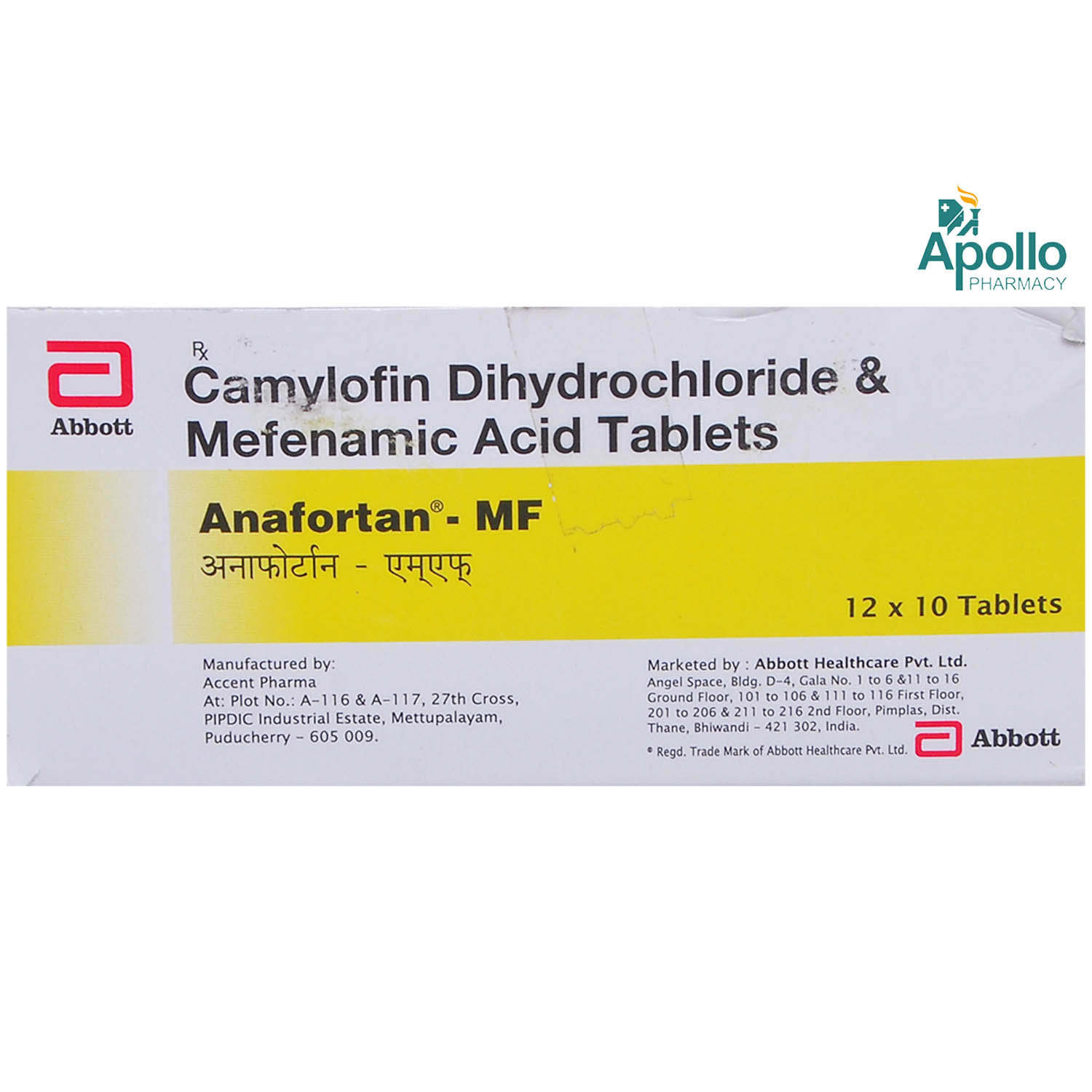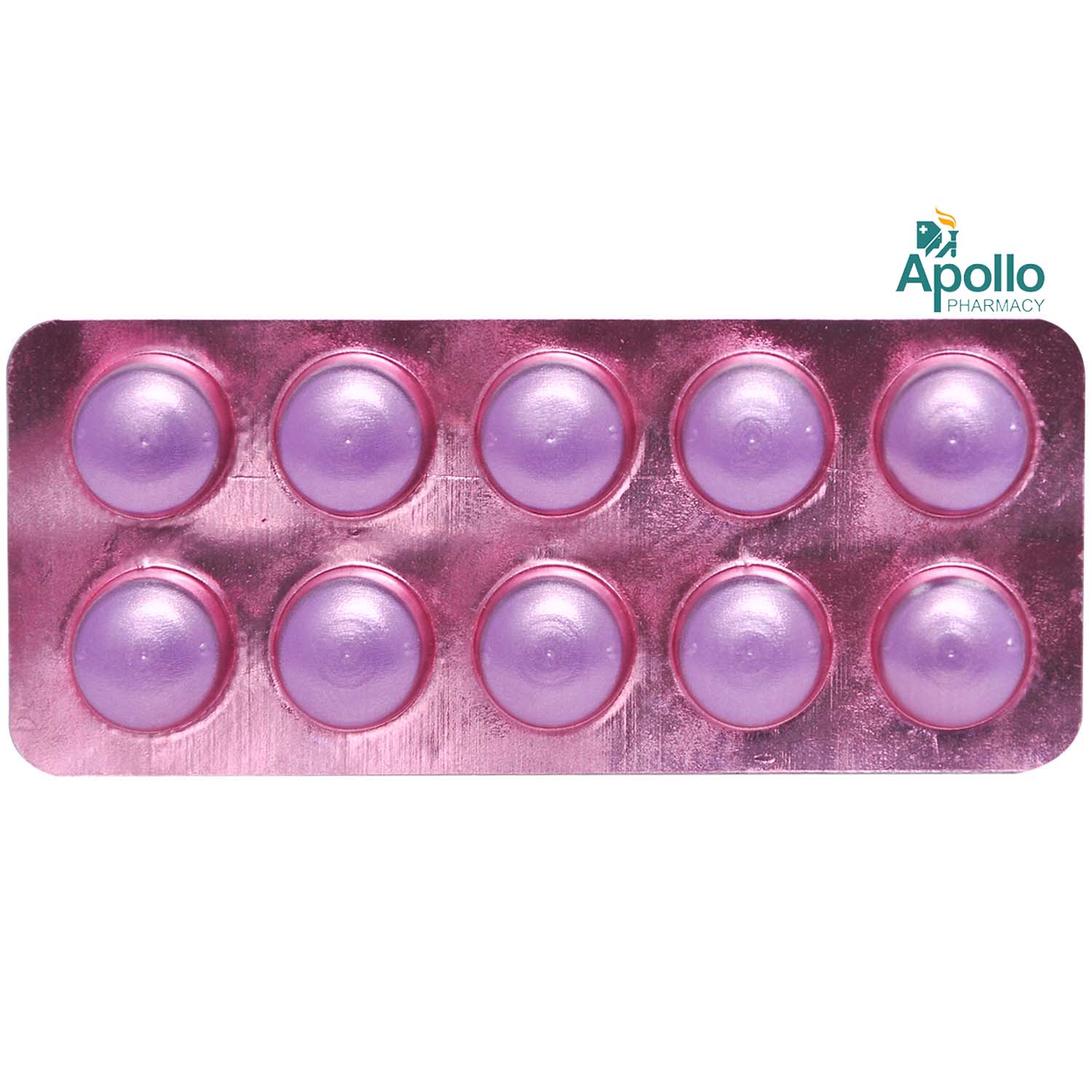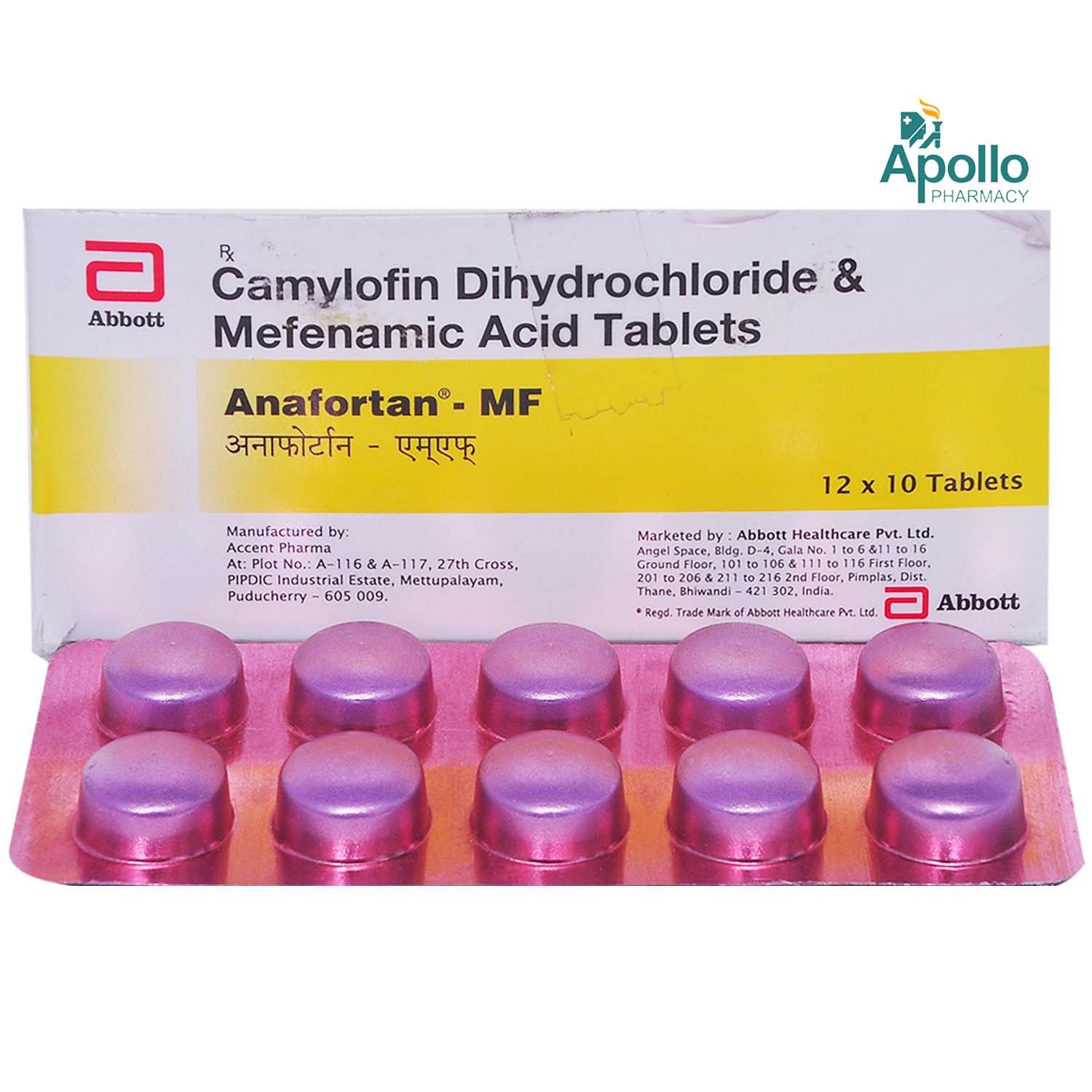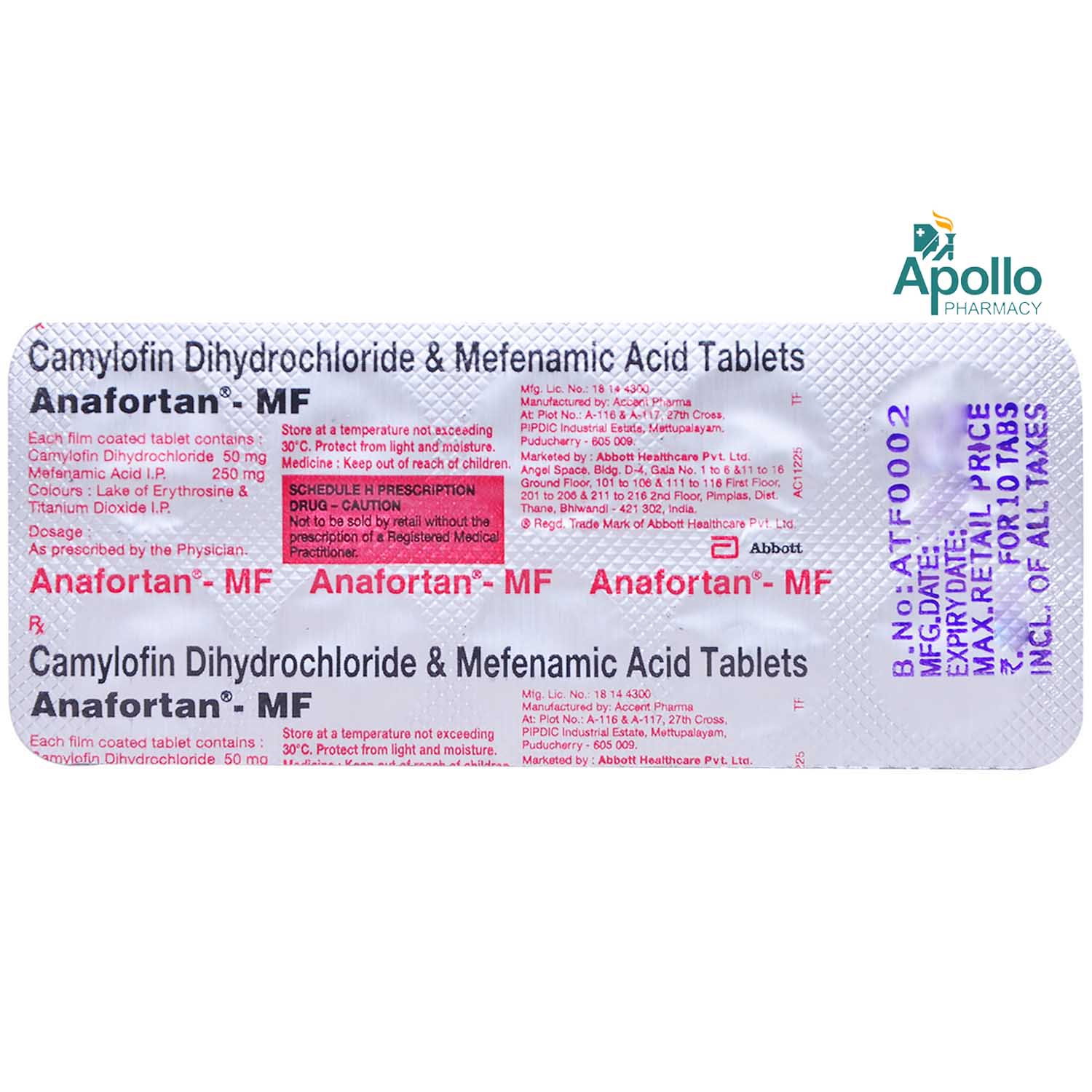Anafortan MF Tablet 10's










MRP ₹105.5
(Inclusive of all Taxes)
₹15.8 Cashback (15%)
Provide Delivery Location
Online payment accepted
 Prescription drug
Prescription drugWhats That
Composition :
Manufacturer/Marketer :
Consume Type :
Return Policy :
Expires on or after :
About Anafortan MF Tablet
Anafortan MF Tablet is a combination drug primarily used to reduce abdominal pain caused due to Intestinal colic, Biliary colic, Renal colic, Dysmenorrhea, Pancreatitis, etc. The colic pain could be because of the spasm or obstruction of intestinal, biliary or uterine smooth muscles. The clinical presentation of spasm could be acute, subacute or chronic in nature. These cramps can range from mild to severe.
Anafortan MF Tablet is composed of two medicines: Camylofin (antispasmodic) and Mefenamic acid (analgesic). Mefenamic acid is an NSAID's and has both analgesic (pain reducer) and antipyretic (fever reducer) properties and decreasing inflammation. It blocks a chemical messenger in pain that is responsible for making a person sense pain. Camylofin is an anti-cholinergic which relaxes the muscles in the stomach and gut (intestine) and stops sudden muscle contractions (spasms). In doing this, it relieves cramps, pain, bloating and discomfort. Together, they effectively reduce pain.
Anafortan MF Tablet is generally safe to consume. Some people may experience dizziness, nausea (feeling sick), digestion problems (constipation, flatulence, diarrhea) and skin reactions (like rashes, hives). Most of the side effects of Anafortan MF Tablet do not require medical attention and gradually resolve over time. However, if the side effects are persistent, reach out to your doctor.
Anafortan MF Tablet should be used with caution in persons dealing with thyrotoxicosis, obstructive lung disease or in the persons dealing with fever and during cardiac surgery. Anafortan MF Tablet should be used with caution in persons above 65 years and in persons dealing with urinary retention, cardiac insufficiency, pregnancy and breastfeeding.
Uses of Anafortan MF Tablet
Directions for Use
Medicinal Benefits
Anafortan MF Tablet is composed of two medicines: Camylofin (antispasmodic) and Mefenamic acid (analgesic). Mefenamic acid is an NSAID's and has both analgesic (pain reducer) and antipyretic (fever reducer) properties and decreasing inflammation. It blocks a chemical messenger in pain that is responsible for making a person sense pain. Camylofin is an anti-cholinergic which relaxes the muscles in the stomach and gut (intestine) and stops sudden muscle contractions (spasms). In doing this, it relieves cramps, pain, bloating and discomfort. Together, they effectively reduce pain.
Storage
- Inform your doctor about dizziness symptoms. They may adjust your medication regimen or prescribe additional medications to manage symptoms.
- Follow your doctor's instructions for taking medication, and take it at the same time every day to minimize dizziness.
- When standing up, do so slowly and carefully to avoid sudden dizziness.
- Avoid making sudden movements, such as turning or bending quickly, which can exacerbate dizziness.
- Drink plenty of water throughout the day to stay hydrated and help alleviate dizziness symptoms.
- If you're feeling dizzy, sit or lie down and rest until the dizziness passes.
- Track when dizziness occurs and any factors that may trigger it, and share this information with your doctor to help manage symptoms.
- Inform your doctor about the nausea and discuss possible alternatives to the medication or adjustments to the dosage.
- Divide your daily food intake into smaller, more frequent meals to reduce nausea.
- Opt for bland, easily digestible foods like crackers, toast, plain rice, bananas, and applesauce.
- Avoid certain foods that can trigger nausea, such as fatty, greasy, spicy, and smelly foods.
- Drink plenty of fluids, such as water, clear broth, or electrolyte-rich beverages like coconut water or sports drinks.
- Use ginger (tea, ale, or candies) to help relieve nausea.
- Get adequate rest and also avoid strenuous activities that can worsen nausea.
- Talk to your doctor about taking anti-nausea medication if your nausea is severe.
- Record when your nausea occurs, what triggers it, and what provides relief to help you identify patterns and manage your symptoms more effectively.
- Inform your doctor about your constipation symptoms. They may adjust your medication or advise alternative treatments.
- Stay hydrated by drinking sufficient of water (at least 8-10 glasses a day) to help soften stool and promote bowel movements.
- Increase fibre intake by eating foods high in fibre, such as fruits, whole grains, vegetables and legumes, to help bulk up the stool.
- Establish a bowel routine by trying to go to the bathroom at the same time each day to train your bowels.
- Engaging in regular exercise, like walking or yoga, can support in bowel movement stimulation.
- Consult your doctor if constipation persists, and discuss alternative treatments or adjustments to your medication.
- Tell your doctor about your GAS symptoms. They may change your medication regimen or prescribe additional drugs to help you manage them.
- To manage GAS symptoms, eat a balanced diet of fibre, vegetables, and fruits.
- Drink enough water throughout the day to avoid constipation and treat GAS symptoms.
- Regular exercise like yoga and walking may help stimulate digestion and alleviate GAS symptoms.
- Take probiotics only if your doctor advises, as they may help alleviate GAS symptoms by promoting gut health.
- Take medication for GAS symptoms only if your doctor advises, as certain medications can interact with your existing prescriptions or worsen symptoms.
- If symptoms persist, worsen, or are accompanied by severe abdominal pain, vomiting, or bleeding, seek immediate medical attention.
- Inform Your Doctor: Notify your doctor immediately about your diarrhoea symptoms. This allows them to adjust your medication or provide guidance on managing side effects.
- Stay Hydrated: Drink plenty of fluids to replace lost water and electrolytes. Choose water, clear broth, and electrolyte-rich drinks. Avoid carbonated or caffeinated beverages to effectively rehydrate your body.
- Follow a Bland Diet: Eat easy-to-digest foods to help firm up your stool and settle your stomach. Try incorporating bananas, rice, applesauce, toast, plain crackers, and boiled vegetables into your diet.
- Avoid Trigger Foods: Steer clear of foods that can worsen diarrhoea, such as spicy, fatty, or greasy foods, high-fibre foods, and dairy products (especially if you're lactose intolerant).
- Practice Good Hygiene: Maintain good hygiene to prevent the spread of infection. To stay healthy, wash your hands frequently, clean and disinfect surfaces regularly, and avoid exchanging personal belongings with others.
- Take Anti-Diarrheal Medications: If your doctor advises, anti-diarrheal medications such as loperamide might help manage diarrhoea symptoms. Always follow your doctor's directions.
- Keep track of your diarrhoea symptoms. If they don't get better or worse or are accompanied by severe stomach pain, blood, or dehydration signs (like extreme thirst or dark urine), seek medical help.
- Inform your doctor about dry mouth symptoms. They may adjust your medication regimen or prescribe additional medications to manage symptoms.
- Drink plenty of water throughout the day to help keep your mouth moist and alleviate dry mouth symptoms.
- Chew sugar-free gum or candies to increase saliva production and keep your mouth moisturized.
- Use saliva substitutes, such as mouthwashes or sprays, only if your doctor advises them to help moisturize your mouth and alleviate dry mouth symptoms.
- Avoid consuming smoking, alcohol, spicy or acidic foods, and other irritants that may aggravate dry mouth symptoms.
- Schedule regular dental check-ups to keep track of your oral health and handle any dry mouth issues as they arise.
- Hydrate your body: Drink enough water to prevent dehydration and headaches.
- Calm Your Mind: Deep breathing and meditation can help you relax and relieve stress.
- Rest and Recharge: Sleep for 7-8 hours to reduce headache triggers.
- Take rest: lie down in a quiet, dark environment.
- Cold or warm compresses can help reduce tension.
- Stay Upright: Maintain good posture to keep symptoms from getting worse.
- To treat headaches naturally, try acupuncture or massage therapy.
- Over-the-counter pain relievers include acetaminophen and ibuprofen.
- Prescription Assistance: Speak with your doctor about more substantial drug alternatives.
- Severe Headaches: Seek emergency medical assistance for sudden, severe headaches.
- Frequent Headaches: If you get reoccurring headaches, consult your doctor.
- Headaches with Symptoms: Seek medical attention if your headaches include fever, disorientation, or weakness.
Drug Warnings
Gastrointestinal bleeding, ulcer formation are commonly observed while taking Anafortan MF Tablet so the doctor may prescribe you the lowest dose available. Do not take Anafortan MF Tablet if you have asthma or allergies to pain killers, heart, kidney and liver conditions. Anafortan MF Tablet should not be taken during pregnancy or by breastfeeding mothers as it may affect the baby. You are recommended not to take alcohol along with Anafortan MF Tablet to avoid unpleasant side effects. Taking Anafortan MF Tablet can cause drowsiness or blurred vision, avoid driving or performing any other activity that requires concentration after taking Anafortan MF Tablet . Always keep your doctor informed about the ongoing medications or the ones you have taken in the past, including over-the-counter medicines and herbal medicines. If you observe any skin rashes or blister formation immediately stop taking Anafortan MF Tablet and consult a doctor. Patients taking Anafortan MF Tablet and antivitamin K (blood thinners) should be monitored for appropriate coagulation and bleeding complications.
Drug-Drug Interactions
Drug-Drug Interactions
Login/Sign Up
Coadministration of Anafortan MF Tablet with Ketorolac can increase the risk or severity of gastric bleeding and ulcers.
How to manage the interaction:
Taking Anafortan MF Tablet with Ketorolac together can result in an interaction, it can be taken if your doctor has advised it. However, if you notice any unusual bleeding or bruising, other signs of bleeding, dizziness, lightheadedness, red or black tarry stools, coughing up or vomiting blood, severe headache, and weakness, you should contact a doctor immediately. Do not stop using any medications without talking to a doctor.
Co-administration of Anafortan MF Tablet with Meloxicam together can increase the risk or severity of bleeding.
How to manage the interaction:
Taking Anafortan MF Tablet with Meloxicam together is generally avoided as it can result in an interaction, it can be taken if a doctor has advised it. However, if you notice any unusual bleeding or bruising, other signs of bleeding, dizziness, lightheadedness, red or black tarry stools, coughing up or vomiting blood, severe headache, and weakness, you should contact a doctor immediately. Do not stop using any medications without talking a doctor.
Co-administration of Anafortan MF Tablet with Flurbiprofen can increase the risk or severity of gastric bleeding, ulceration, and rarely, perforation leading to serious blood loss.
How to manage the interaction:
Taking Anafortan MF Tablet with Flurbiprofen together can result in an interaction, it can be taken if your doctor has advised it. However, if you notice any symptoms of dizziness, lightheadedness, unusual bleeding or bruising, red or black tarry stools, coughing up or vomiting blood, severe headache, and weakness, you should contact a doctor immediately. Do not stop using any medications without talking to a doctor.
Taking Human immunoglobulin with Anafortan MF Tablet, may raise the risk of kidney problems.
How to manage the interaction:
There may be a possibility of interaction between Human immunoglobulin and Anafortan MF Tablet, but it can be taken if prescribed by a doctor. However, if you experience nausea, vomiting, loss of appetite, increased or decreased urination, sudden weight gain or loss, fluid retention, swelling, shortness of breath, muscle cramps, tiredness, weakness, dizziness, confusion, or an irregular heart rhythm, consult a doctor. Do not discontinue any medications without consulting a doctor.
Teriflunomide may cause liver damage and taking it with Anafortan MF Tablet may increase that risk.
How to manage the interaction:
Although taking Anafortan MF Tablet and Teriflunomide together can cause an interaction, it can be taken if your doctor has suggested it. If you have any of these symptoms, it's important to contact your doctor right away - liver problems, fever, feeling cold, pain in your joints, swelling, bruises, rash, itchy skin, not feeling hungry, feeling tired, feeling sick, throwing up, dark urine, or bleeding. Do not discontinue any medications without consulting a doctor.
Coadministration of Anafortan MF Tablet with Deferasirox can increase the risk or severity of gastric bleeding.
How to manage the interaction:
Taking Anafortan MF Tablet with Deferasirox together can result in an interaction, it can be taken if your doctor has advised it. However, if you notice any symptoms of increased or decreased urination, fluid retention, swelling, shortness of breath, muscle cramps, tiredness, weakness, dizziness, confusion, and irregular heart rhythm, you should contact a doctor immediately. Do not stop using any medications without talking to a doctor.
The combined use of Anafortan MF Tablet and Tenofovir alafenamide can increase the risk of kidney problems.
How to manage the interaction:
Taking Anafortan MF Tablet and Tenofovir alafenamide together can lead to an interaction, it can be taken if advised by your doctor. However, if you experience any symptoms like nausea, vomiting, loss of appetite, increased or decreased urination, sudden weight gain or weight loss, fluid retention, swelling, shortness of breath, bone pain, muscle cramps, tiredness, weakness, dizziness, confusion, and irregular heart rhythm, contact a doctor immediately. Do not discontinue any medications without consulting a doctor.
Co-administration of Anafortan MF Tablet with Ibrutinib can increase the risk or severity of bleeding, leading to serious blood loss.
How to manage the interaction:
Taking Anafortan MF Tablet with Ibrutinib together can result in an interaction, it can be taken if a doctor has advised it. However, if you notice any symptoms of unusual bleeding or bruising, dizziness, lightheadedness, red or black tarry stools, coughing up or vomiting blood, severe headache, and weakness, you should contact a doctor immediately. Do not stop using any medications without talking to a doctor.
Coadministration of Anafortan MF Tablet with Dabigatran can increase the risk or severity of bleeding leading to serious blood loss.
How to manage the interaction:
Taking Anafortan MF Tablet with Dabigatran etexilate together can result in an interaction, it can be taken if your doctor has advised it. However, if you notice any unusual bleeding or bruising, other signs of bleeding, dizziness, lightheadedness, red or black tarry stools, coughing up or vomiting blood, severe headache, and weakness, you should contact a doctor immediately. Do not stop using any medications without talking to a doctor.
Coadministration of Anafortan MF Tablet with Methotrexate may increase the blood levels and side effects of methotrexate.
How to manage the interaction:
Although there is a possible interaction between Anafortan MF Tablet and methotrexate, you can take these medicines together if prescribed by your doctor. However, if you experience any symptoms such as nausea, vomiting, diarrhea, rash, appetite loss, joint pain or swelling, yellowing of the skin or eyes, dark urine, breathing difficulty, a dry cough, dizziness or fainting, unusual bruising or bleeding, seizures(fits), mouth sores or ulcers, infection, as well as flu-like symptoms(fever, chills, body pains, sore throat, and weakening of the muscles), consult a doctor immediately. Do not stop using medications without a doctor's advice.
Drug-Food Interactions
Drug-Food Interactions
Login/Sign Up
Diet & Lifestyle Advise
- Include more glucosamine, chondroitin sulfate, Vitamin D, calcium-enriched supplements. Besides this, turmeric and fish oils can help in reducing pain and inflammation in the tissue.
- Please do not go for heavy exercise as it may increase your abdominal pain. Instead, you can do stretching, low impact aerobic exercise (like walking on the treadmill, bike riding, and swimming), simple forms of yoga. You can also strengthen your muscle strength by lifting light weights and doing muscle stretching regularly.
- Your sitting posture is important, especially when have pain and inflammation condition. Try to sit as little as possible and only for a short time (10-15 min). Use back support like a rolled-up towel at the back of your curve to minimize pain. Keep your knees and hips at a right angle.
- You can consume caffeine but not too much as high caffeine intake may cause irritability, poor sleep, and menstrual cramps.
Side Effects of Anafortan MF Tablet
- Palpatations
- Arrhythmia
- Increased heart rate
- Dry skin
- Excessive thirst
- Dryness in mouth
- Photophobia
- Flushing
- Difficulty or painful urination
- Nausea
- Vomiting
- Constipation
Habit Forming
Therapeutic Class
All Substitutes & Brand Comparisons
RX
Out of StockSpasmonorm M Tablet 10's
Khandelwal Laboratories Pvt Ltd
₹51
(₹5.1 per unit)
46% CHEAPERRX
Out of StockBIGSPAS M TABLET
Manking
₹197.8
(₹17.41 per unit)
83% COSTLIER
Product Substitutes
Drug-Diseases Interactions
Drug-Diseases Interactions
Login/Sign Up
FAQs
Some women experience painful periods, also known as dysmenorrhea. The abdominal pain of menstrual cramps may vary from mild to severe, which may also be accompanied by other symptoms, like lower back pain, nausea, diarrhoea, and headaches.
It is advised to tell your doctor if taking other medicines as Anafortan MF Tablet should not be advised to such persons taking blood-thinner warfarin, medicine to treat epilepsy and medicine to treat tuberculosis (TB).
It is advised to store Anafortan MF Tablet in the tightly closed container. Keep Anafortan MF Tablet out of reach of pets, children and other people.
Take the missed dose as soon as you remember it. However, if it is almost time for the next dose, skip the missed dose and continue your regular dosing schedule. Do not take a double dose of Anafortan MF Tablet to make up for a missed one.
The use of Anafortan MF Tablet is contra-indicated if you are allergic to any of its components. And also, it should be taken carefully in patients with kidney or liver disease. Anafortan MF Tablet passes into the breast milk and can affect the baby, so avoid its intake.
Anafortan MF Tablet is usually used for short-term pain relief and can be discontinued if there is no pain. However, please inform your doctor if you feel better and do as advised.
It has been reported that the use of Anafortan MF Tablet can cause diarrhea in some cases. In the case of diarrhea, increase the intake of fluids like drink plenty of water. If still, diarrhea persists, inform your doctor and do as advised.
Anafortan MF Tablet should be used with caution in patients with BPH, as it may worsen the symptoms of BPH. It should be used only when prescribed by a doctor.
No, do not use Anafortan MF Tablet if you have Intestinal obstruction, unless prescribed by a doctor.
Anafortan MF Tablet is not recommended for use in patients undergoing heart surgery or patients who have recently undergone heart surgery due to the increased risk of serious adverse effects. Consult your doctor for further advice.
Drug-Drug Interactions Checker List
- RIFAMPICIN
- METHOTREXATE
- ISONIAZID
- AMANTADINE
- WARFARIN
- CAPTOPRIL
- ENALAPRIL
Special Advise
Taking more than the daily prescribed dose of Anafortan MF Tablet may cause liver damage or allergic reactions like swelling of the mouth, face, throat, difficulty in breathing, skin rash, or itching.
Disease/Condition Glossary
Intestinal colic: It is a cramp-like pain that originates in the small or large intestine. It's caused by a blockage that keeps food and liquid from passing through the body.
Biliary colic: Biliary colic is a dull pain in the middle to the upper right area of the abdomen. It occurs when a gallstone blocks the bile duct, the tube that normally drains bile from the gallbladder to the small intestine.
Renal colic: It is a type of pain you get when urinary stones block part of your urinary tract.
Dysmenorrhea: Painful menstrual periods that are caused by uterine contractions.
Pancreatitis: It is inflammation of the pancreas and causes abdominal tenderness and pain.

Have a query?
Buy best Gastro Enterology products by
Abbott India Ltd
Sun Pharmaceutical Industries Ltd
Alkem Laboratories Ltd
Cipla Ltd
Torrent Pharmaceuticals Ltd
Intas Pharmaceuticals Ltd
Mankind Pharma Pvt Ltd
Lupin Ltd
Dr Reddy's Laboratories Ltd
Aristo Pharmaceuticals Pvt Ltd
Alembic Pharmaceuticals Ltd
Wallace Pharmaceuticals Pvt Ltd
La Renon Healthcare Pvt Ltd
Leeford Healthcare Ltd
Macleods Pharmaceuticals Ltd
J B Chemicals & Pharmaceuticals Ltd
Zydus Healthcare Ltd
Micro Labs Ltd
Zydus Cadila
Fourrts India Laboratories Pvt Ltd
Morepen Laboratories Ltd
Zuventus Healthcare Ltd
FDC Ltd
Eris Life Sciences Ltd
Cadila Pharmaceuticals Ltd
Medishri Healthcare Pvt Ltd
Alniche Life Sciences Pvt Ltd
Medley Pharmaceuticals Ltd
Tas Med India Pvt Ltd
Signova Pharma
Tablets India Ltd
Elder Pharmaceuticals Ltd
Wockhardt Ltd
Emcure Pharmaceuticals Ltd
Sanatra Healthcare Ltd
Glenmark Pharmaceuticals Ltd
Blue Cross Laboratories Pvt Ltd
East West Pharma India Pvt Ltd
Hetero Drugs Ltd
Indoco Remedies Ltd
Vasu Organics Pvt Ltd
Biological E Ltd
Primus Remedies Pvt Ltd
Akumentis Healthcare Ltd
Corona Remedies Pvt Ltd
Pfizer Ltd
Albert David Ltd
DR Johns Lab Pharma Pvt Ltd
Ajanta Pharma Ltd
Cadila Healthcare Ltd
Ipca Laboratories Ltd
Ordain Health Care Global Pvt Ltd
Systopic Laboratories Pvt Ltd
Ozone Pharmaceuticals Ltd
Foregen Healthcare Ltd
Medgen Drugs And Laboratories Pvt Ltd
Panacea Biotec Ltd
Samarth Life Sciences Pvt Ltd
Shine Pharmaceuticals Ltd
Adonis Laboratories Pvt Ltd
Dey's Medical Stores (Mfg) Ltd
Eskag Pharma Pvt Ltd
Hetero Healthcare Pvt Ltd
Indchemie Health Specialities Pvt Ltd
Meyer Organics Pvt Ltd
RPG Life Sciences Ltd
Troikaa Pharmaceuticals Ltd
Biochem Pharmaceutical Industries Ltd
Shreya Life Sciences Pvt Ltd
Sinsan Pharmaceuticals Pvt Ltd
3M India Ltd
Chemo Healthcare Pvt Ltd
Levin Life Sciences Pvt Ltd
Meridian Enterprises Pvt Ltd
Overseas Health Care Pvt Ltd
Saf Fermion Ltd
Sanzyme Pvt Ltd
Steris Healthcare
USV Pvt Ltd
Seagull Pharmaceutical Pvt Ltd
Votary Laboratories (India) Ltd
Win Medicare Ltd
Yuventis Pharmaceuticals
Aar Ess Remedies Pvt Ltd
Caplet India Pvt Ltd
Piramal Enterprises Ltd
Sanofi India Ltd
Cnx Health Care Pvt Ltd
Galpha Laboratories Ltd
Intra Labs India Pvt Ltd
Kinesis Pharmaceuticals Pvt Ltd
Msn Laboratories Pvt Ltd
Olcare Laboratories Pvt Ltd
Rapross Pharmaceuticals Pvt Ltd
Ronyd Healthcare Pvt Ltd
Saffron Therapeutics Pvt Ltd
Solariz Healthcare Pvt Ltd
Syndicate Life Sciences Pvt Ltd
Aurz Pharmaceutical Pvt Ltd
Biophar Lifesciences Pvt Ltd
Alcohol
Unsafe
You are recommended not to consume alcohol along with Anafortan MF Tablet as it contains mefenamic acid, which can together damage your liver severely.
Pregnancy
Caution
Anafortan MF Tablet should be used during pregnancy only if the potential benefit overweighs potential risk to the fetus.
Breast Feeding
Caution
Anafortan MF Tablet should not be used if you are breast-feeding. Anafortan MF Tablet passes into breast milk, so it is not recommended for use during breast-feeding unless considered essential by your doctor.
Driving
Unsafe
Anafortan MF Tablet may cause dizziness, drowsiness and visual disturbances, which may affect their ability to drive or operate machinery. Make sure you are not affected before driving or operating machinery.
Liver
Caution
Anafortan MF Tablet to be taken with caution, especially if you have a history of Liver diseases/conditions. The dose may have to be adjusted by your doctor.
Kidney
Caution
Anafortan MF Tablet to be taken with caution, especially if you have a history of Kidney diseases/conditions. The dose may have to be adjusted by your doctor.
Children
Unsafe
Anafortan MF Tablet is not to be used in children below 12 years of age.





